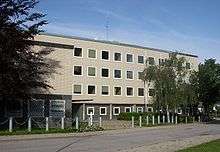West German Embassy siege
The West German Embassy siege in Stockholm, Sweden, was a hostage standoff initiated by the Red Army Faction (RAF) on 24 April 1975.[1] Collectively, the attackers referred to themselves as Kommando Holger Meins, after Holger Meins, an RAF member who had died of starvation during a (collective) hunger strike in Wittlich Prison on 9 November 1974.
| West German Embassy siege | |
|---|---|
 German embassy in Stockholm (photo from 2008) | |
| Location | Stockholm, Sweden |
| Coordinates | 59°20′4.36″N 18°6′22.96″E |
| Date | 24 April 1975 12.00 – 23.47 (CET) |
| Target | West German embassy |
Attack type | Siege, hostage crisis |
| Weapons | TNT, submachine guns |
| Deaths | 2 embassy personnel, 2 perpetrators |
| Injured | 10 embassy personnel, 4 perpetrators |
| Perpetrators | Kommando Holger Meins/Red Army Faction |
The RAF group carried out the attack with the goal of forcing the release of RAF members and others[2] from prison in West Germany.[3] During the siege they stated: "The Holger Meins Commando is holding members of the embassy staff in order to free prisoners in West Germany. If the police move in, we shall blow the building up with 15 kilos of TNT."
The siege
The group consisted of six members: Karl-Heinz Dellwo, Siegfried Hausner, Hanna-Elise Krabbe, Bernhard Rössner, Lutz Taufer and Ulrich Wessel. They entered the embassy, took thirteen embassy officials, including ambassador Dietrich Stoecher, hostage (or twelve officials, according to some sources), and then proceeded to occupy the upper floors of the building.[4]
They warned Swedish police to back off or some hostages would be killed, but the police did not comply and one of the hostages, Baron Andreas von Mirbach, a German military attaché was marched out on to the landing and shot dead. Coincidentally his late relative Wilhelm von Mirbach who served as German Ambassador to Russia was assassinated at the German embassy in Moscow by Left Socialist-Revolutionaries in 1918.
Chancellor Helmut Schmidt, having experienced another hostage crisis just weeks before, was not prepared to negotiate with them.[5] In response, economic attaché Hillegaart was made to stand at a window, and was then shot three times. With the murder of Hillegaart, the attackers announced they would execute one hostage every hour until their demands were met.
Swedish police prepared to storm the building, but before they had the chance to do so, the embassy was rocked by a series of violent explosions; the TNT had somehow been detonated.[6] It turned out that one of the terrorists, Ulrich Wessel, had dropped a grenade, which killed him and detonated the TNT cache. The remaining hostages, as well as the other RAF members, all suffered severe burns. Siegfried Hausner was flown back to West Germany, where he soon died of his wounds in prison.
The explosion of the embassy was caught on tape. Swedish news reporter Bo Holmström was standing outside the embassy ready to broadcast when the explosions took place. After taking cover Holmström started yelling "Lägg ut, lägg ut!" ("Put it on, put it on!"), i.e. "Put me on the air!". Once he knew he was live he began reporting on the events.
See also
References
- "BBC on this day 24 April". BBC News. 24 April 1975. Retrieved 23 July 2015.
- Dellwo, Karl-Heinz (2007). Das Projektil sind Wir (in German). Hamburg: Verlag Lutz Schulenburg. p. 5. ISBN 978-3-89401-556-5.CS1 maint: ref=harv (link)
- Ascherson, Neal (28 September 2008). "A terror campaign of love and hate". The Guardian. London. Retrieved 23 July 2015.
- "5 terrorists seize embassy" (PDF).
- Blumenau, Bernhard (2014). The United Nations and Terrorism. Germany, Multilateralism, and Antiterrorism Efforts in the 1970s. Basingstoke: Palgrave Macmillan. p. 32. ISBN 978-1-137-39196-4.
- "German terrorists captured after embassy bomb attack" (PDF).
Literature
- Blumenau, Bernhard. The United Nations and Terrorism. Germany, Multilateralism, and Antiterrorism Efforts in the 1970s. Basingstoke: Palgrave Macmillan, 2014, pp. 22, 32, 37, 117. ISBN 978-1-137-39196-4